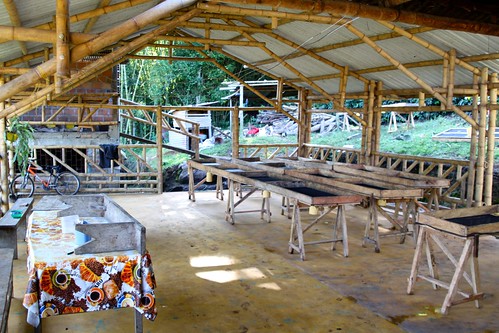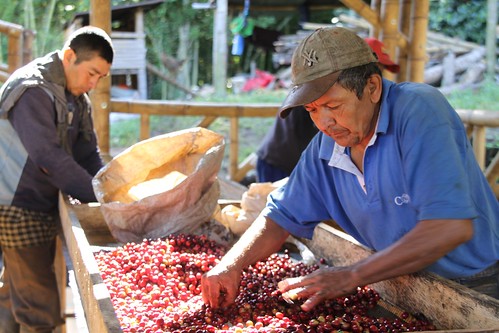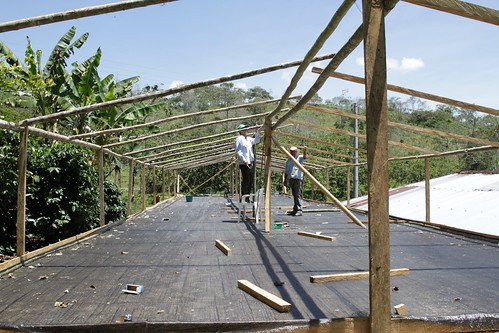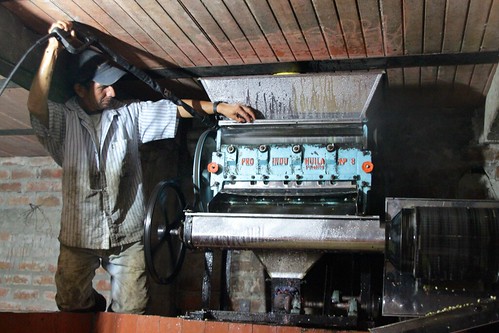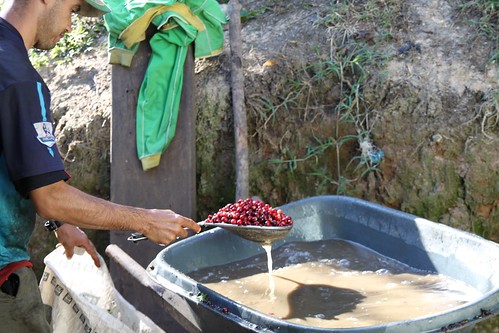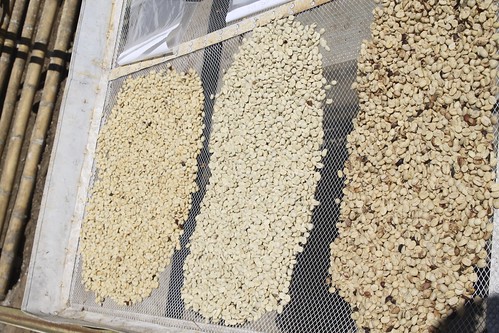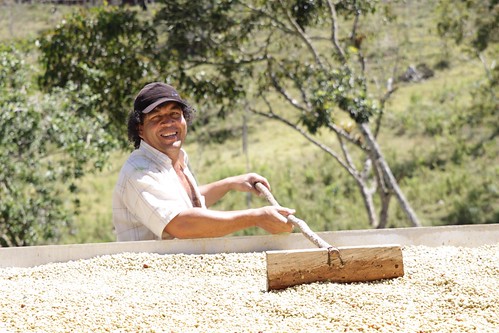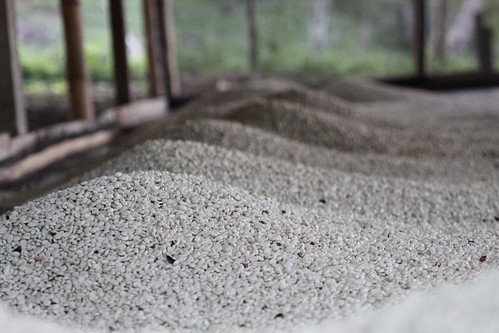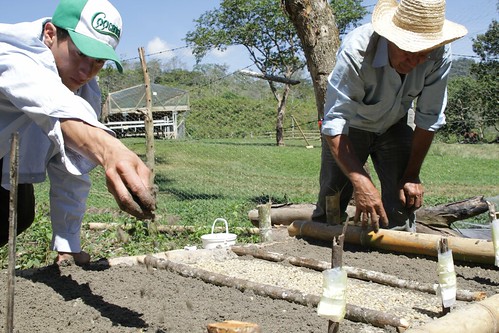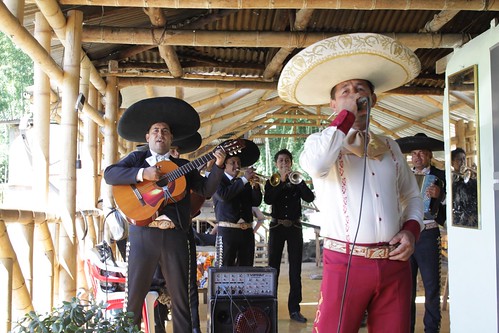I have just spent a week in Colombia together with Don Elias at Finca Tamana. He is now starting his main harvest, and in a couple of weeks we will be starting to sell the recently arrived November 2012 harvest in our store.
My reason for visiting was to follow up on all the projects we have started at Finca Tamana. You can view a short summary of all the work here, or watch my lecture from the 2102 Nordic barista cup. I have also been blogging a lot from the farm in the past year.
Don Elias has been working really hard in order to improve the farm since November. In fact, he was so determined to finish building new dryers, that he could not afford to fertilize his coffee plants 3 times like he wanted to. Although he got some funds from our 5 year anniversary to build more infrastructure on the farm, he had spent a bit too much on the infrastructure and therefore could only fertilize the coffee fields 2 times for this harvest. Regardless of this, the shrubs looked really healthy and were producing well, so I am not concerned about this.
When I first came to the farm, I was met by the sight of a new huge cement patio on which Elias had set up sorting tables for the prickers to sort the coffee cherries before it is delivered for processing. In the past, the pickers have been sitting on a dirty ground sorting the cherries, which is very bad both in terms of ergonomics and also because the cherries gets a bit dirty before processing.
With the new sorting tables, the workers are standing up sorting the cherries, and the tables have a hole in one corner in order to make it easier and more efficient to empty the cherries in to buckets and carry them to the receiving tank.
A new drying patio (bamboo structure covered with a surface of nylon) was also under construction. This will be covered with a plastic roof constructed so that it lets the hot and humid air out and ensures good air circulation. It will also be shaded with a nylon net, in order to prevent the coffee from over heating. After some experiments the past year, Don Elias and I agreed that for the future he will shift to building tradidional raised beds as they have better air circulation and is more ergonomical for the workers. These will of course be placed under shade.
Elias had finally got hold of a high pressure washer too. (one that worked with his variable water pressure) This was used to clean the wet mill, de-pulping machine, the sorting tables, buckets, patios and pretty much everything on the farm that could be cleaned with water. The farm now looks cleaner than ever.
The food was also better this time as Don Elias’ wife, Bella (right in picture below), had returned to the farm after being seriously ill for some months. I was very happy to see her in good form again, and Don Elias seemed a little less stressed during my visit. Maybe because not only is Bella cooking great food, she also takes care of the accounting among a lot of other tasks on the farm.
After spending a day at the farm discussing with Don Elias how we could improve the process even further, we sat down and wrote a plan for the rest of the week in order to make sure we got to execute all the ideas we had in mind.
First day we simplified the wet process a bit. Although it is just a detail, we decided to give the de-mucilaged parchment coffee a rinse with clean water before the fermentation. The reason being to slow down the fermentation process slightly to prevent over fermentation on hot days and to clean off dirt from the actual cherry as they are quite dirty when they are being de-pulped.
The pickers had also implemented a flotation step of the cherries prior to sorting, to make the job a bit easier as a lot of the over ripe cherries float. This was done in a wheelbarrow, but Don Elias will get a better solution for this for the next harvest. This not only makes it easier to sort the cherries, but it also cleans the cherries a bit before de-pulping.
The result of our improved process at Finca Tamana is not only showing results in the cup, but also visually it makes a big difference. Just look at the picture below. The coffee to the left is processed by using the traditional dry fermentation and drying for 6 to 9 days in the sun like most farmers in Huila are doing. The coffee in the middle is produced by our technique, which implements more rinsing and a post fermentation and washing soak. (the parchment is soaked in clean water for 20 hours after washing) Then the coffee is dried carefully in the shade.
The coffee to the right is the pasillas, meaning the overripe and half ripe cherries that are removed from the middle coffee before processing and then being processed separately. This coffee is sold for a low price for local consumption in Colombia and is not suited for export.
We also tried to improve the drying process. In November, Don Elias was drying his coffee for up to 60 days as the climate in the area is humid and shifting between rain and sun every day. In order to try to speed it up, we moved the african beds he made last year, out from the shade and in in to the sun. The idea is to replicate the skin drying step they use in Kenya. The parchment is dried for the first day on these beds in the sun in order to get rid of the excess water and moisture from the washing process. This makes the risk of mould and fungus formation on the coffee a lot lower. The coffee needs to be stirred every 15 to 30 minutes the whole day. This seemed to work well on sunny days, but I am more worried about the rainy days. Therefore Don Elias will build some plastic cover in order to protect the coffee from rain yet still ensure good airflow.
After the first day of drying, the coffee is moved in to the shade where it is dried slowly for up to 30 to 40 days until the moisture content reaches 10-12%. In order to prevent the coffee from gaining moisture during the humid nights we are now piling up the coffee and covering it before it gets dark.
The coffee also needs to be stirred continuously throughout the whole drying process in order to ensure even drying. Don Elias hired one of the workers to do this all day, and this will of course add an extra cost to the production.
In addition, Don Elias is paying the pickers a much better salary than the average in the area. Also since the coffee is dried for more than 20 to 30 days longer than what is normal, he is struggling with his cash flow in order to finance the workers.
I therefore offered to pre-finance the coffee for him so that he does not have to worry about how to get money to pay his workers. We also discussed the price for the coffee and I promised that I will make sure the extra costs are covered in the final price of the coffee. Although our USD 4 per lb (453g) FOB price seems like a great price for coffee in Colombia, it is not necessarily a fantastic price for Don Elias, as the way he produces his coffee now is a lot more expensive than what is normal in Colombia. I have therefore decided we need to review the price with him and make sure we pay a price that is more sustainable. In other words, since we demand better quality, we better pay for it as well.
The last thing we did before I left the farm was to plant 4 new varieties. Hopefully some of them will taste great and be more resistant to leaf rust than the traditional Caturra variety he is growing. Since leaf rust is a huge problem in Colombia and Central-America, Don Elias planted some Castillo variety on the farm, 3 years ago. The Castillo will have it’s first production this harvest and I can’t wait to taste it as I have had a lot of good experience cupping this new variety in the past. The Castillo is an improved development of Variedad de Colombia which Don Elias is already growing with great results at Finca Tamana.
On the last afternoon, Don Elias threw a surprise birthday party for me. He had hired some mariachis from La Plata which were truly awesome. In the late afternoon we had organized a game of football (soccer) with the pickers and a team from another farm. Although team Real TW-ER Tamana lost 0-4, we had a good celebration in the evening with all the workers on the farm. I can’t wait to get back in July and November to see the further developments of this project.

